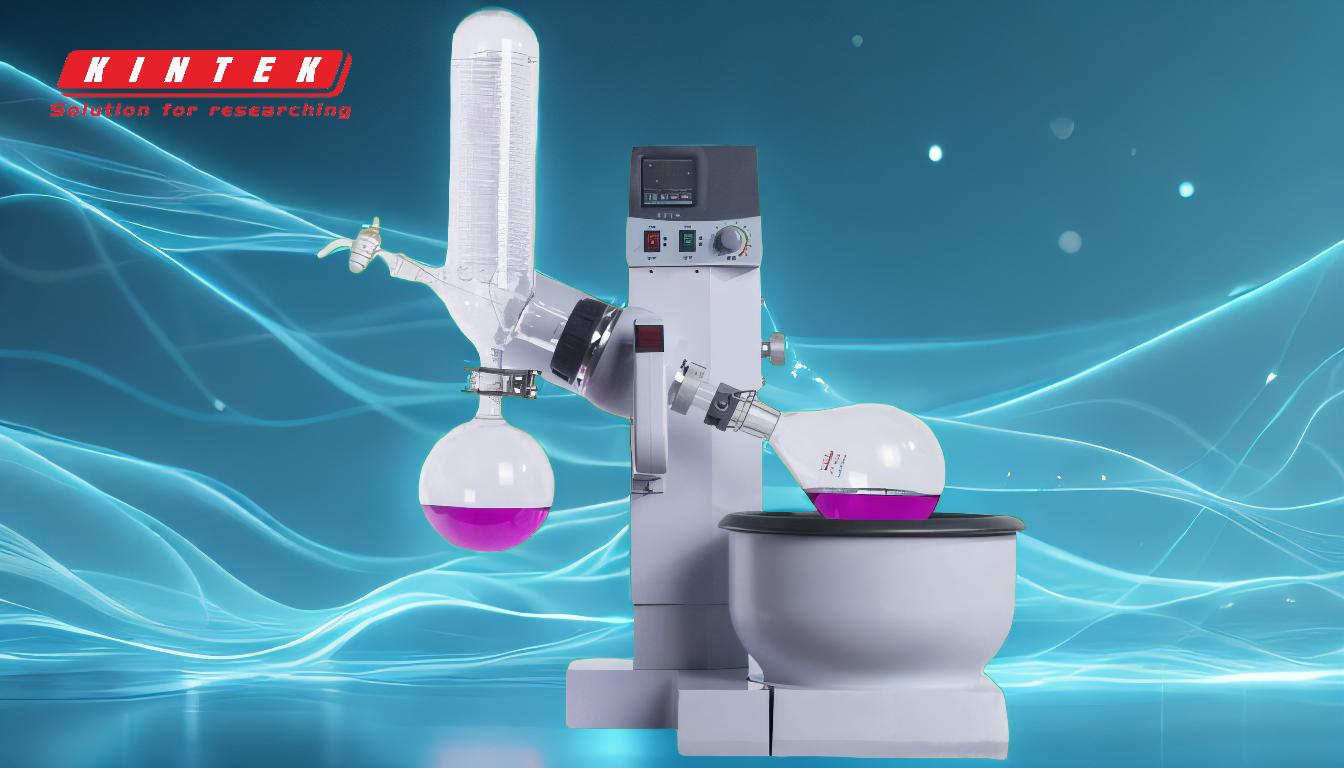A rotary evaporator is a sophisticated laboratory instrument designed for efficient solvent removal, concentration, and separation of mixtures. It consists of several interconnected components that work together to facilitate controlled evaporation under reduced pressure. The key components include a motor unit for rotating the evaporation flask, a vacuum system to lower pressure, a heated fluid bath for temperature control, a condenser to cool and condense vapors, and a collection flask to gather the condensed solvent. Additional features like a bump guard, vacuum release valve, and spin speed controls enhance safety and precision. Understanding these components is crucial for optimizing performance and ensuring safe operation.
Key Points Explained:

-
Motor Unit:
- The motor unit is responsible for rotating the evaporation flask at a controlled speed, typically between 150-200 rpm.
- Rotation creates a thin film of the sample on the inner surface of the flask, increasing the surface area for efficient evaporation.
- The motor is often connected to a ground glass-joint guide tube, which ensures a secure and vacuum-tight connection to the flask.
-
Vacuum System:
- A vacuum pump is used to reduce the pressure inside the system, lowering the boiling point of the solvent and enabling evaporation at lower temperatures.
- The vacuum system is connected to the condenser side via vacuum tubing, ensuring a continuous and controlled reduction in pressure.
- A vacuum release valve is often included to safely restore atmospheric pressure when needed.
-
Heated Fluid Bath:
- The water bath (or other heated fluid bath) provides controlled heating to the evaporation flask, typically maintained at 30-40°C.
- Heating accelerates the evaporation process while preventing thermal degradation of sensitive compounds.
- Temperature control knobs allow precise adjustment to suit specific solvent properties.
-
Condenser:
- The condenser is responsible for cooling and condensing the evaporated solvent vapors back into liquid form.
- It may use a coolant coil or a "cold finger" design, with temperatures set between -10°C to 0°C to ensure efficient condensation.
- The condenser is a critical component for solvent recovery and minimizing loss.
-
Condensate-Collecting Flask:
- The collecting flask captures the condensed solvent, allowing for easy recovery and measurement.
- It is positioned below the condenser and is typically made of durable glass to withstand chemical exposure.
-
Evaporation Flask:
- The rotating flask, usually a round-bottomed design, holds the sample mixture and is partially immersed in the heated bath.
- It is filled to no more than 50% of its volume to prevent bumping and ensure efficient evaporation.
-
Bump Guard:
- A bump guard or trap is included to prevent sudden boiling or "bumping" of the sample, which can lead to contamination or loss of material.
- This feature enhances safety and process stability.
-
Mechanical or Motorized Mechanism:
- A lifting mechanism allows the evaporation flask to be raised or lowered from the heating bath, providing control over the evaporation rate.
- This feature is particularly useful for handling heat-sensitive samples.
-
Vapor Duct:
- The vapor duct serves as the axis for sample rotation and provides a vacuum-tight conduit for vapor to travel from the evaporation flask to the condenser.
- It ensures a seamless flow of vapors while maintaining system integrity.
-
Control Knobs and Interfaces:
- Spin speed and bath temperature control knobs allow users to fine-tune the evaporation process for optimal results.
- These controls are essential for adapting the system to different solvents and sample types.
By understanding these components and their functions, users can effectively operate a rotary evaporator, ensuring efficient solvent recovery and safe handling of chemical processes.
Summary Table:
| Component | Function |
|---|---|
| Motor Unit | Rotates the evaporation flask (150-200 rpm) for efficient evaporation. |
| Vacuum System | Lowers pressure to reduce boiling points and enable controlled evaporation. |
| Heated Fluid Bath | Provides precise heating (30-40°C) to accelerate evaporation safely. |
| Condenser | Cools and condenses solvent vapors for recovery. |
| Condensate Flask | Collects the condensed solvent for easy measurement. |
| Evaporation Flask | Holds the sample mixture and rotates for uniform evaporation. |
| Bump Guard | Prevents sample bumping, ensuring safety and stability. |
| Lifting Mechanism | Adjusts flask height for precise control over evaporation rates. |
| Vapor Duct | Provides a vacuum-tight conduit for vapor flow. |
| Control Knobs | Fine-tunes spin speed and bath temperature for optimal performance. |
Need help choosing or operating a rotary evaporator? Contact our experts today for personalized guidance!











